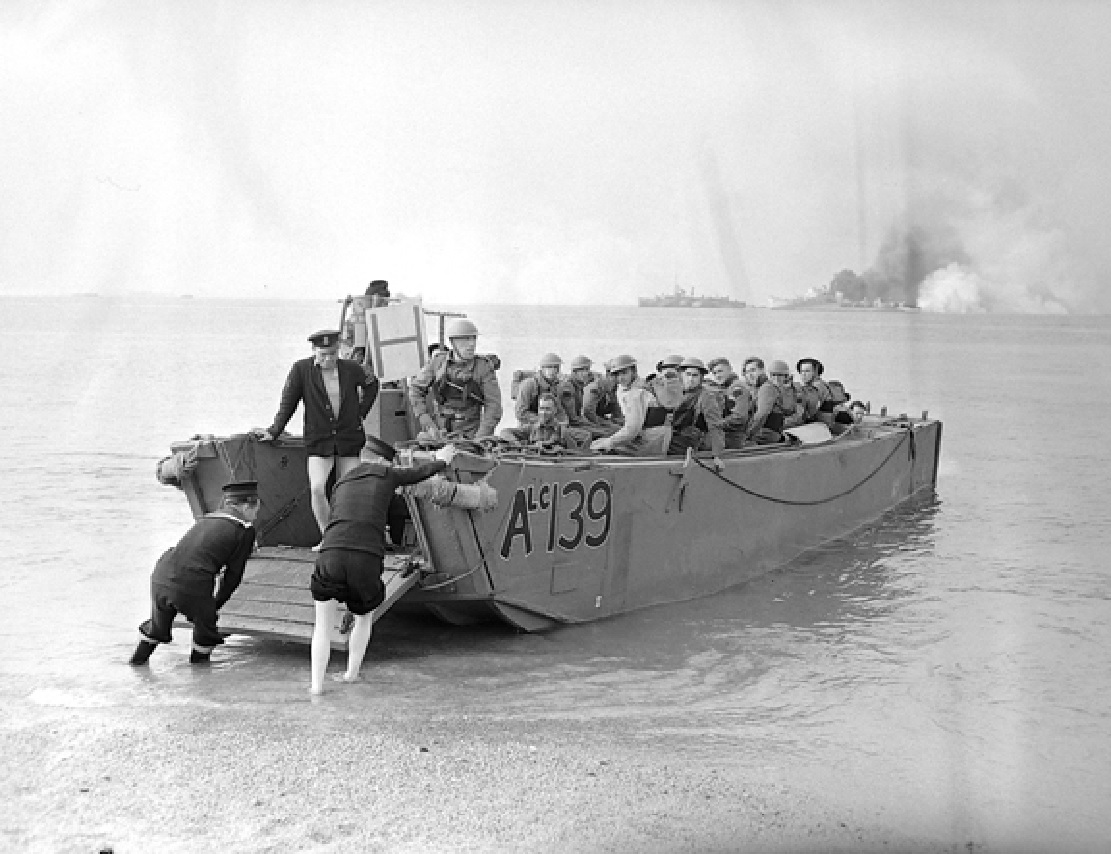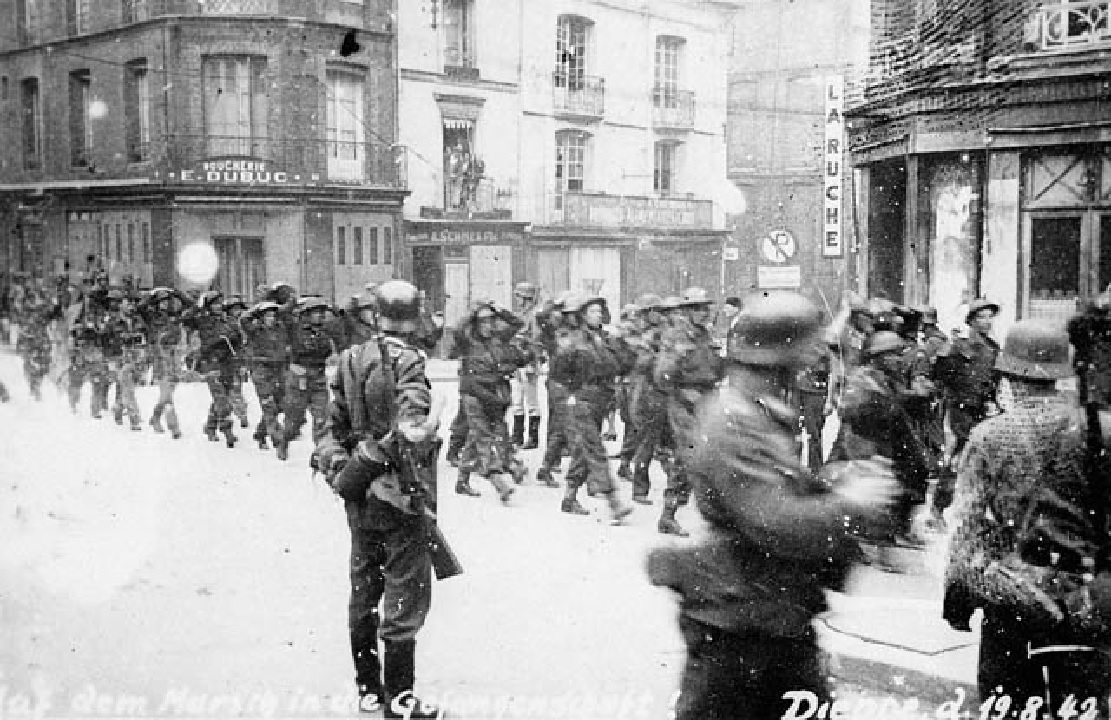History Canada: Aug 19, 1942, The disastrous raid on Dieppe
Dieppe #Dieppe

he deadly result of enfilade fire during the Dieppe Raid of 1942: dead Canadian soldiers lie where they fell on “Blue Beach”. Trapped between the beach and fortified sea wall, they made easy targets for MG 34 machineguns in a German bunker. The bunker firing slit is visible in the distance, just above the German soldier’s head, (Bundesarchiv 1011-291 1230-13)
In the summer of 1942 the war was raging in places around the world. Malta was fighting for its survival, the situation in N. Africa was in doubt as Germans and British fought back and forth across the desert, in the Pacific the Japanese were sweeping across land and sea, and in Europe massive bombing of German cities and strategic industry were being carried out.
In Canada, the battle of the St Lawrence had begun with the sinking of the freighter Nicoya by a German U-boat in May. Other U-boat attacks on shipping would follow.
On the eastern front there was bitter fighting between German forces and Russian defenders in a back and forth desperate struggle for supremacy and survival. For months Russia had been hotly pressuring Britain and it’s Allies to open a western front to relieve German pressure.
Resources however were few and a western front was simply not possible. Britain decided instead on a ‘raid’ to divert German attention and more resources from the east, and to demonstrate some action to their Russian allies.
On this date, August 19, 1942, that effort took place, and ended in disaster.
The original plan ‘Operation Rutter’ was set for July, but called off due to weather. It called for an attack on the German-held coastal towns of Dieppe, Pourville, and Puys, with flanking commando attacks on Varengeville, Quiberville and Bernevald all along a 17 kilometre coastline. They were to do as much damage to German installations as possible, and withdraw the same day . Years later it would also be revealed there was a secret aspect to capture parts and learn about German Freya radar, an effort that succeeded only in small part. There have also been claims it was to hide the capture of a 4-rotor German naval Enigma coding machine from a Kriegsmarine headquarters, an effort which failed.
Canadian troops had been stationed in England for three years, and their generals eager to see Canadians see action, insisted in taking part.

Canadian soldiers aboard an LCA (landing craft assault) during a practice prior to the Dieppe raid ( Library and Archives Canada Mikan 4341223)
Some reports suggest loose talk in pubs and other observations by informants had alerted Germans to the raid in July. However, that cancelled British plan was revived by Admiral Mountbatten and re-named ‘Operation Jubilee’. Many however had suggested it was unwise to mount the same attack on the same towns only a month later after coastal defences had been increased and since informants had again remarked on more activity in British ports.
Also General Montgomery’s original combined ops plan had been substantially altered. The ‘softening up’ aerial bombardment and shelling from capital ships to disable German defences had been called off along with a planned paratroop landing to attack the Germans from behind.
But on this day in August over 6,000 troops, some 5,000 of which were Canadian, were underway in the night. Many historians have suggested that the British senior command was relying more on ‘luck’ than intensive intelligence gathering and planning and Canadian senior commanders were too eager and not willing to pose questions.
For that luck, surprise was essential and was lost with a chance encounter and firefight with a German coastal ship patrol alerting shore defences. Delayed landings meant the cover of darkness was also lost with easily spotted ships, soldiers and tanks coming ashore in the light of early dawn on beaches well-sighted in by German guns. Only the South Saskatchewan Regiment landed in darkness at Pourville, but the Royal Navy landed a part of them on the wrong beach.
As for the rest, soldiers were cut down by the defences, and through poor British research and planning the tanks were bogged down by the rocky beach on which they landed. Some of the Royal Hamilton Light Infantry made it into the town of Dieppe but unsupported by the disabled tanks, their situation was hopeless.
Misunderstood messages resulted in the Fusiliers Mont Royal reserves being sent in, but in the summer daylight of 7am, they were easy targets. Some 584 were sent in, only 125 got back.
The raid was an almost immediate disaster
Within hours it was all but over, except for a tiny group from the Royal Regiment of Canada which held out until early afternoon.

Canadian prisoners being marched away from the beach through Dieppe (LAC)
In the end almost half the attacking force were killed or captured. Some 907 Canadians were killed on the beaches or subsequent fighting, 586 suffered wounds some dying later in hospital, and 1,946 became prisoners. The British contingent taking part also lost many soldiers killed, wounded and surrendered.
The Royal Navy lost over a quarter of the approximately 250 vessels used for the raid, and over 500 sailors. The RAF and RCAF lost 106 aircraft, a greater single-day loss than all during the Battle of Britain, and bomber raids over Germany to that date.
Lt.Col Cecil Merritt of the South Saskatchewan Regt., eventually taken prisoner, would later be awarded the Victoria Cross for his bravery and actions in leading his men and the hopeless defence during a limited withdrawal across bullet swept beaches.
Reverend John Weir Foote of the Royal Hamilton Light Infantry, also prisoner would also be awarded the Commonwealth’s highest honour for valour for actions of moving wounded to safety under heavy fire.
A German radio news bulletin that evening noted “ The enemy has suffered a decisive defeat. His attempt at invasion served only political purposes and was contrary to all military common sense.”
At the time, the fiasco was claimed to be a success certainly for domestic propaganda purposes, but also as some have since suggested, to protect high ranking officers and political planners reputations.
The Germans also used the fiasco in their propaganda campaigns, again primarily for the German army and domestic purposes.

Although they understood it as a ‘raid’, German propaganda portrayed it as an ‘invasion catastrophe’ ( Universitat Koln archiv- WLU)
The Allied claim, even to this day, is that valuable lessons were learned towards the planning of the eventual D-Day landings and the invasion of the continent.
However, in the end the lessons learned were no how to conduct a landing, but rather how not to. More valuable lessons were learned on conducting an amphibious landing from the Allied invasion of Sicily which would take place a year later.
additional information-sources